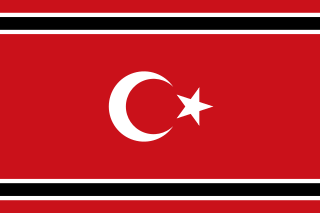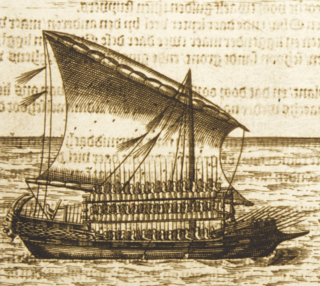Related Research Articles

Aceh, officially the Province of Aceh, is the westernmost province of Indonesia. It is located on the northern end of Sumatra island, with Banda Aceh being its capital and largest city. It is bordered by the Indian Ocean to the west, Strait of Malacca to the northeast, as well bordering the province of North Sumatra to the east, its sole land border, and shares maritime borders with Malaysia and Thailand to the east, and Andaman and Nicobar Islands of India to the north. Granted a special autonomous status, Aceh is a religiously conservative territory and the only Indonesian province practicing Sharia law officially. There are ten indigenous ethnic groups in this region, the largest being the Acehnese people, accounting for approximately 70% of the region's population of about 5.5 million people in mid-2023. Its area is comparable to Croatia or Togo.

The Free Aceh Movement was a separatist group seeking independence for the Aceh region of Sumatra, Indonesia. GAM fought against Indonesian government forces in the Aceh insurgency from 1976 to 2005. Estimates of the death toll total over 15,000 people killed.

The Aceh War, also known as the Dutch War or the Infidel War (1873–1904), was an armed military conflict between the Sultanate of Aceh and the Kingdom of the Netherlands which was triggered by discussions between representatives of Aceh and the United States in Singapore during early 1873. The war was part of a series of conflicts in the late 19th century that consolidated Dutch rule over modern-day Indonesia.

Chow Kit is a suburb in central Kuala Lumpur, Malaysia. It is located around Jalan Chow Kit and is enclosed by the parallel streets of Jalan Raja Laut and Jalan Tuanku Abdul Rahman. It is named after Loke Chow Kit a well-known miner, municipal councilor, public official, and also the first local owner of a department store - Chow Kit & Co – which was the largest in KL at the time.

The klewang or kelewang is a category of traditional single-edged sword that can be found throughout the Malay Archipelago. Usually it is shorter than a pedang (sword) but longer than a golok (machete). There are straight bladed types, but most are curved.

Hasan Muhammad di Tiro, was the founder of the Free Aceh Movement (GAM), an organisation which attempted to separate Aceh from Indonesia from the 1970s. It surrendered its separatist goals and agreed to disarm as agreed to in the Helsinki peace deal of 2005. He was the maternal great-grandson of Tengku Cik di Tiro, an Acehnese guerilla fighter and national hero of Indonesia who was killed fighting the Dutch in 1891. In 2010 he obtained his Indonesian citizenship back shortly before his death.

Pidie Regency is a regency of Aceh Special region, in Indonesia. It is located in the north of the island of Sumatra, in Western Indonesia, bordered by the Malacca Strait and Pidie Jaya Regency in the north, Aceh Besar Regency in the west, Bireuen Regency in the northeast, and Aceh Jaya Regency in the south. The regency covers an area of 3,184.46 square kilometres and had a population of 379,108 people at the 2010 Census and 435,275 at the 2020 Census; the official estimate as at mid 2023 was 448,085 - comprising 223,208 males and 224,877 females. Pidie was the largest rice-producing area of Aceh province, producing some 20% of its total output.
Takengon is a town in Aceh, Indonesia. The town itself sits on three administrative districts of the Central Aceh Regency - Bebesen, Kebayakan, and Lut Tawar, and acts as the seat of Central Aceh Regency. The town is in the highlands of western Sumatra, situated on the shores of Lake Laut Tawar. The region around Takengon is well known for its coffee. Takengon is a plateau with cool air at an altitude of about 1200 m above sea level.

The insurgency in Aceh, officially designated the Rebellion in Aceh by the Indonesian government, was a conflict fought by the Free Aceh Movement (GAM) between 1976 and 2005, with the goal of making the province of Aceh independent from Indonesia. The aftermath of a military offensive in 2003 and the 2004 Indian Ocean earthquake and tsunami brought an peace agreement and an eventual end to the insurgency.

Acehnese is an Austronesian language natively spoken by the Acehnese people in Aceh, Sumatra, Indonesia. This language is also spoken by Acehnese descendants in some parts of Malaysia like Yan, in Kedah. Acehnese is used as the co-official language in the province of Aceh, alongside Indonesian.

The Acehnese, also written as Atjehnese and Achinese, are an indigenous ethnic group native to Aceh, Indonesia on the northernmost tip of the island of Sumatra. The area has a history of political struggle against the Dutch colonial rule. The vast majority of Acehnese people are Muslims. The Acehnese people are also referred to by other names such as Lam Muri, Lambri, Akhir, Achin, Asji, A-tse and Atse. Their language, Acehnese, belongs to the Aceh–Chamic group of Malayo-Polynesian of the Austronesian language family.

The First Aceh Expedition, was a military campaign undertaken by the Royal Netherlands East Indies Army (KNIL) against the sultanate of Aceh in the north of Sumatra in 1873. The expedition was launched as a punitive measure by the Dutch colonial authorities in response to perceived challenges to their control over the region and Aceh's resistance to Dutch interference in its affairs.

Cut Nyak Dhien Airport is an airport located in Nagan Raya Regency, Aceh, Indonesia.
Aneuk Jamèë is an Acehnese term referring to the Minangkabau diaspora who inhabit or settled in the southwestern regions of Aceh in northernmost of the Indonesian island of Sumatra. They speak a distictive dialect of Minangkabau, known as the Jamèë Minangkabau.

Roti canai, or roti prata, also known as roti chanai and roti cane, is a flatbread dish of Indian origin found in several countries in Southeast Asia, especially Brunei, Indonesia, Malaysia, Singapore, and Thailand. It is usually served with dal or other types of curry but can also be cooked in a range of sweet or savoury variations made with different ingredients, such as meat, eggs, or cheese.

The Indonesian Malaysians are Malaysian citizens of Indonesian ancestry. Today, there are many Malaysian Malays who have lineage from the Indonesian archipelago and have played an important role in the history and contributed to the development of Malaysia, they have been assimilated with other Malay communities and are grouped as part of the foreign Malays or anak dagang in terms of race. The Malaysian census does not categorize ethnic groups from the Indonesian archipelago as a separate ethnic group, but rather as Malay or Bumiputera.
Mante people or also spelled as Mantir, are one of the earliest ethnic groups frequently mentioned in legendary folklore to have inhabited Aceh, Indonesia. This ethnic group, along with other indigenous people such as the Illanun people, Sakai people, Jakun people, Senoi and Semang, are the ethnic groups that formed the existing Acehnese people today. The Mante people are regarded as part of the Proto-Malay people group that initially settled around the region of Aceh Besar Regency and in the interior jungle. These indigenous people were thought to have migrated to Aceh through the Malay Peninsula. In the Acehnese legend, the Batak and Mante people were mentioned as the descendants of Kawom Lhèë Reutōïh ; which were also one of the indigenous peoples in Aceh, Indonesia. Today, the Mante people are extinct or have disappeared as a result of intermarriage with other non-indigenous people groups that arrived later. To date, there is no strong scientific evidence for the existence of this people.

Acehnese cuisine is the cuisine of the Acehnese people of Aceh in Sumatra, Indonesia. This cuisine is popular and widely known in Indonesia. Arab, Persian, and Indian traders influenced food culture in Aceh although flavours have substantially changed their original forms. The spices combined in Acehnese cuisine are commonly found in Indian and Arab cuisine, such as ginger, pepper, coriander, cumin, cloves, cinnamon, cardamom, and fennel.

Ghali, gali, or gale are a type of galley-like ships from the Nusantara archipelago. This type of ship only appeared after the 1530s. Before the appearance of this type of ship, several native galley-like ships already existed in the archipelago, some with outriggers. The design of ghali is the result of the impact made by Mediterranean shipbuilding techniques on native shipbuilding, introduced particularly by Arabs, Persians, Ottoman Turks, and Portuguese. The terms may also refer to Mediterranean vessels built by local people, or native vessels with Mediterranean influence.
